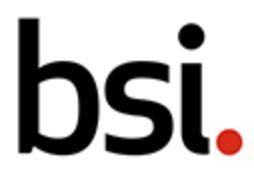This week we have three standards under review
Proposal: ISO/TC 299 N 518, ISO/NP 22166-203 Robotics — Modularity for service robots — Part 203: Information Model for Hardware
Please visit: http://standardsdevelopment.bsigroup.com/projects/9022-07016
Comment period end date: 27/05/2022
Scope
This document complies with the ISO 22166-1 and CD 22166-200 family standards providing requirements and guidelines on modularity for service robots. This 203 part presents the detailed requirements and guidelines for information model for all modules except software(AMES) modules (hardware modules, modules with hardware and software aspects, etc.), as well as physical interfaces of modules.
Typical examples are presented.
Purpose
This document provides requirements and guidelines for information model and physical interfaces for hardware to achieve the following:
– Enable efficient data exchange between AMESmodules,
– Efficient connections between physical interfaces for AMES hardware,
– Easy integration of AMES modules without any extra effort for interactions among modules,
– Allow AMES module designers and manufacturers to define and use functions of modules for achieving their own characteristics for service robot modules,
– Provide AMES module users with appropriate modules depending on functions of a target service robot and user’s affordable expense.
For the active utilization of service robot modules and effective expansion of service robot market, it is necessary to share information of AMES modules via information model approach for ease exchanging purpose while satisfying required interoperability, reusability, safety and security. The output of the document will accelerate the expansion of service robot hardware market as well as service robot market and robot application services. In addition, developers, designers, and manufactures of service robots can utilize various types of AMES modules with ease and at lower cost and provide service robots more suitable for end users.
Proposal: ISO/NP 27548 – Additive manufacturing of plastics — Environment, health and safety — Test method for determination of particle and chemical emission rates from desktop 3D printer material extrusion.
Please visit: http://standardsdevelopment.bsigroup.com/projects/9022-06988
Comment period end date: 29/04/2022
Scope
This document specifies test methods to determine particle emissions (including ultrafine particles) and specified VOCs (including aldehydes) from Material Extrusion(ME) processes often used in nonindustrial environments such as school, homes and office spaces in an Emission Test Chamber (ETC) under specified test conditions. However, these tests may not accurately predict real-world results.
This document describes a conditioning method using an ETC with controlled temperature, humidity, air exchange rate, air velocity, and procedures for monitoring, storage, analysis, calculation, and reporting of emission rates.
This document is intended to cover a Fused Filament Fabrication (FFF) type desktop 3D printer using thermoplastic materials. The primary purpose of this document is to quantify particle and chemical emission rates emitted from a specific ME type desktop 3D printer which is operated using thermoplastic feedstocks.
However, not all possible emissions are covered by this method. Many feedstocks could release hazardous emissions that are not measured by the chemical detectors prescribed in this document. It is the responsibility of the user to understand the material being printed and the potential chemical emissions. An example is PVC feedstocks that could potentially emit chlorinated compounds, which would not be measured by this document.
Purpose
In the frame of the agreement between CEN, ISO and ASTM for additive manufacturing standards, it is proposed to adopt this new project as an EN ISO/ASTM standard.
***
3D printing market which creates three-dimensional objects from digital modelling file has been recently expanded with enormous growth. However, significant aerosol emissions have been found from lowcostdesktop 3D printing operations for personal uses and student education. Academic communities in the U.S. and France have released several papers warning that significant number of particles emitted from 3D printing would be hazardous to humans when they are inhaled and absorbed into human body
Proposal: ISO/ASTM NP 52929 – Adoption as an EN ISO ASTM – Additive manufacturing of metals Powder bed fusion – Presentation of material properties in material data sheets.
Please visit http://standardsdevelopment.bsigroup.com/projects/9022-06987
Comment period end date: 16/05/2022
Scope
This document specifies basic content and relevant parameters to be reported in material data sheets. Individual additions and extensions are permissible. This document is intended for manufacturers of PBF-LB/M or PBF-EB/M equipment, powder suppliers, service providers and users of the additively manufactured components.
Purpose
Equipment manufacturers and service providers publish material properties for additively manufactured components or specimens produced by pow-der bed fusion of metals using laser or electron beams.
Such publications are not comparable, due to missing specifications on how associated measurements were conducted. For example, the number of specimens tested, the number of build jobs used, the specimen´s geometry and variations due to orientation are individually determined and usually not published.
This document creates the prerequisites for the derivation and reporting of material properties of an AM machine uniform and transparent, in conjunction with its associated process chain. For this purpose, the boundary conditions of specimen production, sample size used and the number of build jobs to derive the indicated properties, shall be specified. Material data sheets prepared in accordance with this document will provide a suitable basis for assessment and judgement on the performance of the tested equipment and material, subject to the corresponding process boundary conditions.
If you have any comment or need more information, please contact Sami Ortiz at sami.ortiz@mta.org.uk

